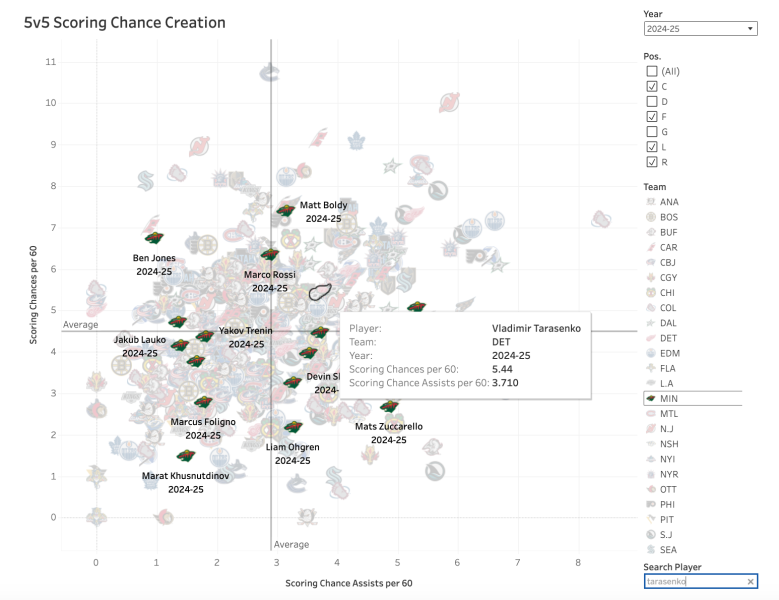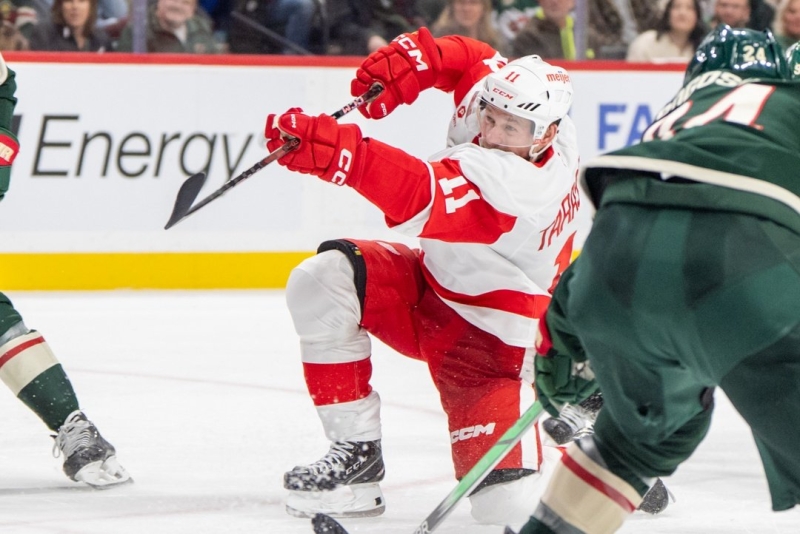Before diving into Vladimir Tarasenko’s game, it must be said up top:
There’s no such thing as a bad one-year deal.
The Minnesota Wild acquired Tarasenko from the Detroit Red Wings on Monday in a cap dump trade where they gave up nothing. In a league where few teams are actually against the salary cap, the “Get a player for nothing” market is rapidly dying. Still, Minnesota managed to do just that for a team that had $15 million of wiggle room heading into free agency. For this, they’ll get a former six-time 30-goal scorer for one year, $4.75 million.
Granted, the days of Tarasenko being one of the most feared scorers in the NHL are behind him. Still, we’re gonna see way dumber contracts dished out once free agency opens tomorrow. It’s a nifty bit of work by Bill Guerin and his front office.
But making a good-looking move in the summer is one thing. Now Tarasenko has to actually play, and his presence puts Minnesota in a spot where they don’t have to make a move to acquire a scoring winger tomorrow… at least on paper.
Long term, this is good news for Minnesota. Brock Boeser would be intriguing on a three- or four-year deal. Six or seven years would probably be asking for trouble. The Wild are in a position where they can either let a Boeser deal come to them or turn down an unfavorable deal, knowing Tarasenko sets a certain floor.
But, where is that floor? Last year, Tarasenko scored just 11 goals and 33 points for the Red Wings. His skating took a dive last year, and he’s always relied on his shot. That’s usually not a recipe for aging super well, and given that Tarasenko is 33, that’s kind of a red flag.
Still, Tarasenko is just one year removed from scoring 23 goals and 55 points for the Ottawa Senators and Florida Panthers. The run in Florida is especially encouraging. He played 43 games (regular season and playoffs), scoring 11 goals and 23 points with bottom-six minutes. That’s not bad. Neither is winning a Stanley Cup.
The Wild aren’t the Panthers, though, and Tarasenko isn’t starting the season in the bottom-six. Minnesota seems to have him penciled into the second line, and that’s likely going to come with about 16 to 17 minutes per night. The last two teams that had him in that role had an 81-point season (2022-23 St. Louis Blues) and a 78-point season (2023-24 Ottawa). That’s got to be a concern.
Not that playing Tarasenko under 15 minutes a night helped the 86-point Red Wings too much last season. So, let’s look into why Tarasenko flopped in Detroit and how the Wild might be able to avoid a similar fate.
At first blush, it seems like Tarasenko had an awkward fit with his linemates, playing about half the season with J.T. Compher and Jonatan Berggren. Both players have some skill, but they didn’t complement Tarasenko’s abilities at this stage of his career. Neither Compher nor Berggren is a terrific puck-carriers, per Corey Sznajder’s All Three Zones tracking project. While Tarasenko used to be strong in the role in his St. Louis days, he’s no longer able to be that go-to zone entry guy.
No clean zone entries means few attempts on the rush, which has generally been where Tarasenko has been productive throughout the years. When he put up 52 points two seasons ago, he had entry wizard Tim Stützle riding shotgun with him in Ottawa, and Sasha Barkov carrying in pucks in Florida.
The bad news is, the only elite puck-carriers the Wild have are Kirill Kaprizov and Marcus Johansson. There’s only one Kaprizov, and a big reason the Wild are trading for Tarasenko in the first place is to keep Johansson firmly in the bottom-six. If Tarasenko is on the second line, either Marco Rossi is going to have to embrace a puck-carrying role that he deferred to Kaprizov last season, or Matt Boldy is going to have to get a touch better at entering the zone cleanly.
If the Wild can find someone to serve as Tarasenko’s caddy and set-up man, he can still do some damage in the offensive zone. Even with the Red Wings last year, All Three Zones had him as above-average in both generating and facilitating scoring chances. That’s something the Wild badly need, because they had few dual-threat players last season.

The card for Tarasenko partially obscures Ryan Hartman (who was above-average at both, but skewed towards Scoring Chance Assists) and Kaprizov (average at Scoring Chances, elite at Scoring Chance Assists). Besides those two, only Boldy, Rossi, and Vinnie Hinostroza were average or better at both aspects of offense for Minnesota last season.
That hints at Tarasenko having use on the second line, but that won’t be the ideal outcome for Minnesota. At least, not by the end of the year.
Tarasenko hasn’t been a stout defender for about a decade, and his defensive game has cratered over the past four years. He might still have some offense left in him, but he’ll give some on the back end, particularly if he’s out and ready to be exploited for 16 minutes a night. The ideal situation is that Tarasenko eventually settles into the lineup on a scoring third line. Perhaps even a fourth-line that gets sheltered minutes in the offensive zone to maximize opportunities at 5-on-5.
So Tarasenko might not be a great addition as a second-line solution, but that’s not his value to the Wild. What Tarasenko does is buy Minnesota time. If Öhgren and Yurov aren’t ready for a second-line role to begin the season, the Wild don’t have to force it. They can get their feet wet on the third line, and hopefully be ready to swap places with Tarasenko by January or so.
And if their prospects aren’t ready to make that jump, Minnesota can turn to the trade market at the deadline. Unlike now, there will be teams who are resigned to finishing in the basement around March. Even if top-tier players aren’t available, the Wild can be in on some pending UFA forward to give them a boost heading into the playoffs.
That’s a lot better than backing up a Brinks truck for Boeser and hoping he can be their big fish solution for the next seven seasons. Tarasenko might not give the Wild a long-term solution, but he represents a floor that the Wild’s second line isn’t going beneath, no matter what. Even if he can only thrive in a depth role at his age, Tarasenko is more than worth having around at his price, for his term, and for the low, low cost of nothing via trade.
